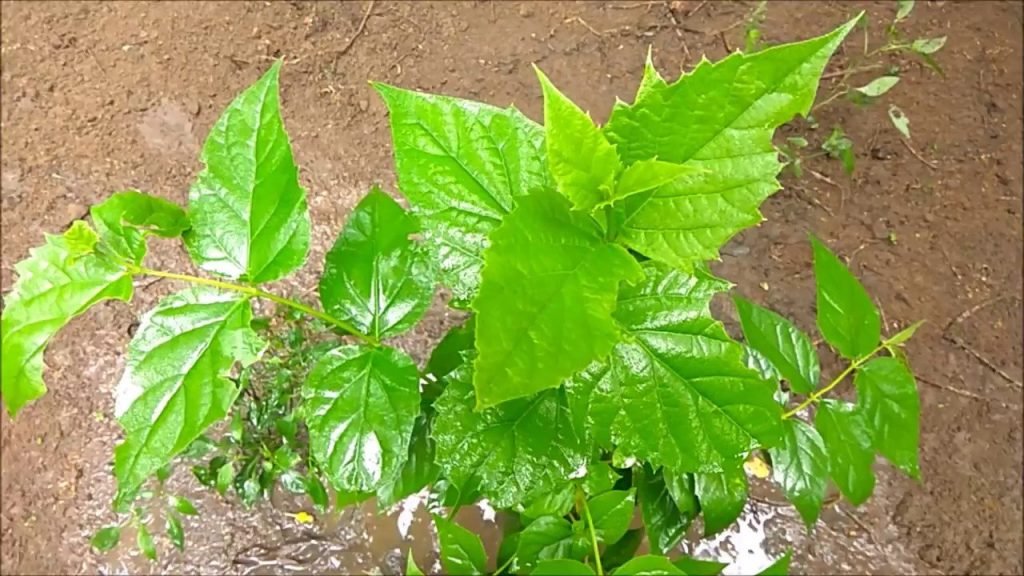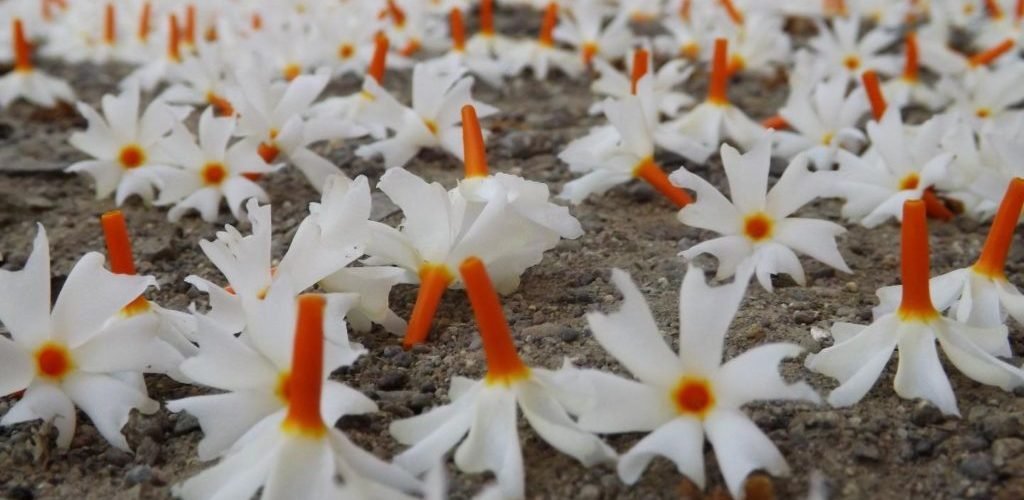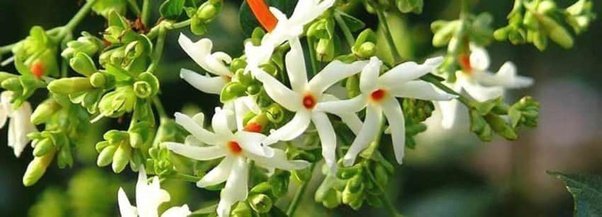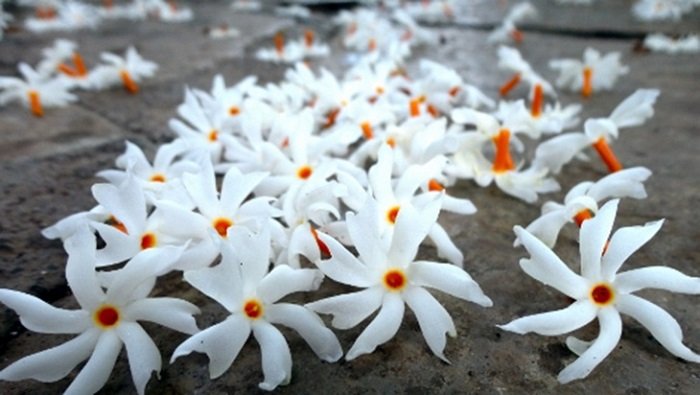On August 5, 2020, Prime Minister of India Narendra Modi participated in “Bhoomi Pujan” or a groundbreaking ceremony, which marks the construction of the Ram Temple in Ayodhya. Before laying the foundation stone of the temple, PM Modi planted a Parijat/Harsingar plant in the temple premises.

Importance in Hinduism: Krishna uprooted the manuscript from the Parijat tree, a Bhagavata Purana. Parijat appears in many Hindu religious stories and is often related to Kalpavriksha. In one story, which appears in the Bhagavata Purana, the Mahabharata and the Vishnu Purana, Parijat appeared as a result of Samudra Manthan and Lord Krishna made war with Indra to win Parijat.

Also, his wife Satyabhama demanded planting trees in the backyard of his palace. It happened that despite her having a tree in her backyard, due to her superior devotion and humility, flowers used to fall in the adjacent backyard of the second queen Rukmini, who was a favorite of Lord Krishna.
The flower is the official flower of the state of West Bengal, and is also known as Parijat, Shefali and Siuli in the local West Bengal region in India. Nyctanthes arbor-tristis is commonly known as night-flowering jasmine and coral jasmine.
It is called Har-Shringar in Mithilanchal and Madhesh in Bihar. It is called Zevali in Assamese, while in Sri Lanka it is called Sipalika. In Kerala, where it is called Pavizamalli in Malayalam, Pavazamalli in Tamil, Purdak in Konkani. In Myanmar, it is called Sikphalu. It is used for Pujas and such ceremonies. It also has significance in old Malayalam romantic songs.
It is the subject of an arrangement called Parijatpaharanamu in Telugu literature written by the court-poet Nandi Thimmana of Krishnadevaraya.
Nyctanthes arbor-tristis is a shrub or a small tree 10 m tall, with a bark of flaky brown color. The flowers are fragrant, with five to eight-lobed white corolla with orange-red center; They are born together in groups of two to seven, with individual flowers opening in the evening and ending at dawn. The fruit is a bilobed, flat brown heart-shaped round capsule.
Plants of coral jasmine tree, udumalpet, Tamil Nadu, India
The tree is sometimes called the “tree of sorrow”, because the flowers lose their luster in the daytime; The scientific name Arbor-Tristis also means “sad tree”. The flowers can be used as a source of yellow dye for clothing. The flower is called Gangasuli and some where there is Jhar Seafali in Odisha, India. In the Burok Tipuri culture of Tripura, it is associated with the cycle of life i.e. birth and death. It is popular as a garland for the dead.
Benefits of Harsingar and its side effects
It provides treatment for dengue, chikungunya, malaria and arthritis. It prevents gas, radical damage, treats cough, fights with breathing problems, in addition it has anti-bacterial, anti-viral and anti-fungal properties, which makes it fight various infections in the body . It also acts as a laxative in most cases.
Nutritional value of Harsingar
The leaves of Harsingar include benzoic acid, fructose, glucose, carotene, amorphous resin, ascorbic acid, methyl salicylate, tannic acid, oleanolic acid and flavon glycosides. The flowers are very beneficial because it contains essential oils and glycosides. The seeds contain palmitic, oleic and myristic acids.

The bark of this plant is useful due to its alkaloids and glycosides content. Extracts of this flower have antifungal and antiviral properties. Apart from this, it also has antileishmanial, hepatoprotective and immunostimulant properties.
Although chikungunya and dengue are serious and require immediate hospitalization of those suffering from it, the intake of Harsingar can provide some help and reduce the symptoms of these diseases. During such illnesses, the patient’s platelet count deteriorates rapidly.
In such cases this herb can be used as a corrective measure to increase blood platelet count as soon as possible. Harsingar should be taken in decoction or raw form along with other herbs to get the best results. According to research, the difference in dengue and chikungunya patients can be seen up to 3 days in advance. However, this herb should be consumed regularly so that there is no major difference.

Can cure arthritis
Gout is not only common in older people, but it also affects today’s young adults. It can be very annoying and distract a person from his daily activities. In severe cases, it also disrupts sleep to some extent. In such situations, Harsingar should be consumed to reduce swelling and pain due to its anti-arthritis properties.
The powder extracted from Harsingar is advised to boil in a cup of water and it is consumed immediately for relief. People who consume it regularly usually experience relief after prolonged use of this herb.
Cures malaria and other fever
Harsingar leaves are used to treat fever, which occurs during chronic malaria. It can also be used as a remedy for high body temperature, diarrhea and nausea caused by mosquito bites. The leaves have beneficial soothing and healing properties, making it ideal for getting rid of malaria parasites.
Protects the body from radical damage
Health problems and the cause of aging are usually fundamental damage to our body cells. This is known as oxidative damage. To prevent such damage, antioxidants are required. Therefore, Harsingar contains strong antioxidants that can easily get rid of the harmful effects of free radicals.
In addition, Harsingar can also be used to stop the growth of cancer cells and fight the early signs of aging. Massage can also be done on the body to keep the essential oils extracted from its flowers healthy and strong.
Anti-allergic, antiviral and antibacterial properties
Harsingar oil can be used to fight bacteria such as E.coli, staph infections and fungal infections. Additionally, it helps in combating encephalomocarditis, cardiovirus, and the Semliki Forest virus. It can also be used to treat skin issues such as blackheads and pimples.
Can cure cough
A persistent cough can occur for many reasons such as smoking, bronchitis, lung problems or throat infections. This can be very annoying and impedes our ability to interact with people and socially. In most cases, coughing can also make sound unable to sleep and lead to fatigue and stress. Harsingar usually helps in relieving cough and if consumed daily it can reduce the symptoms to a great extent.
Have trouble breathing
Regular intake of Harsingar can relieve asthma symptoms. Although it does not cure asthma, it does reduce symptoms and makes it easier for a person to breathe without interruption. Harsingar has beneficial and medicinal properties to provide relief from asthma symptoms.
Acts as a laxative
It is a proven fact that Harsingar helps in dealing with constipation. It is an alternative to laxatives and performs better than one. It contains special minerals, which facilitate the regulation of the digestive system.
Prevents gas
Gas can be extremely irritating and may cause weakness, abdominal pain, and even dizziness. Regular intake of Harsingar easily cures gas problems.
Uses of Harsingar
Harsingar is packed with beneficial uses such as, it helps in treating dandruff, lice, vertigo and anxiety symptoms, scurvy and acidity. Additionally, it also treats hypertension, relieves sciatica menstrual cramps and in some cases is an antidote to snake bites. If you are always restless and have frequent panic attacks then this herb should be consumed. According to studies, Harsingar also reduces hemorrhoids to some extent.
Allergies and side effects of Harsingar
The fatal side effects of Harsingar are not very high, but anything consumed in excess can be harmful to health. Harsingar has very bitter taste, so people who are very sensitive to taste can experience mild nausea if they do not tolerate the taste.
It should not be taken in overdose to cure cough as it can prove fatal to the throat, it should be taken only after guidance of an Ayurvedic doctor for cough related issues. After chewing the leaves of Harsingar, the tongue can also become pale and unattractive.
Harsingar farming
Harsingar usually grows in tropical regions of the world. Although this plant usually blooms at night, it requires a lot of sunlight and cannot survive in a cold or cold area. It grows best in sandy, moist and well drained soil. It cannot grow in highly saline soil. It is commonly found in South Asia and some regions of Asia.

